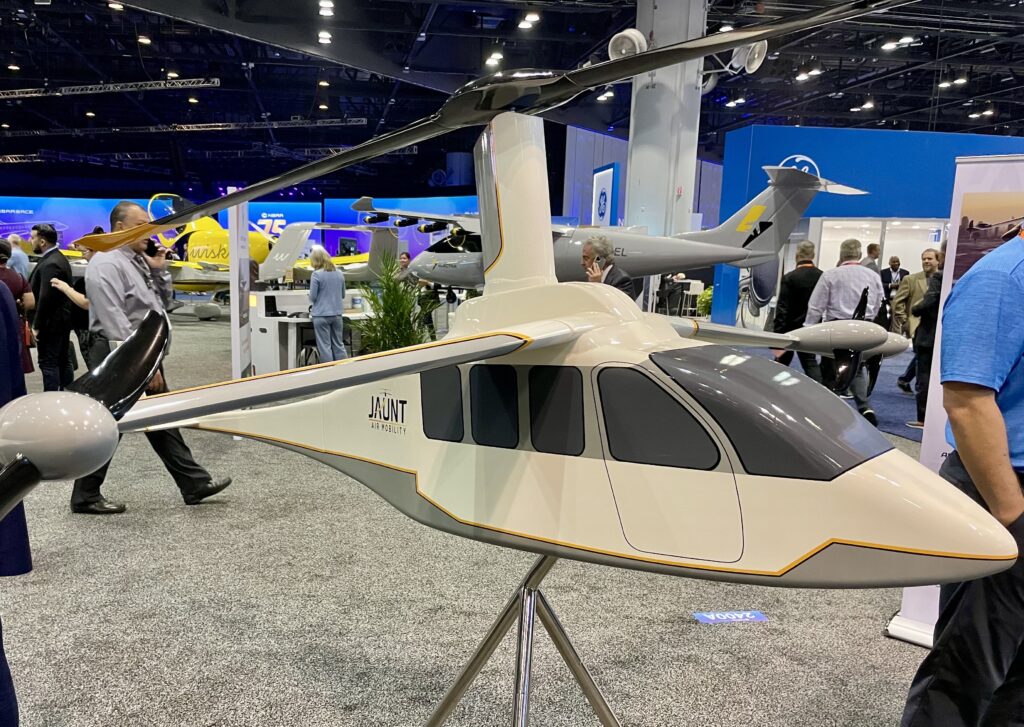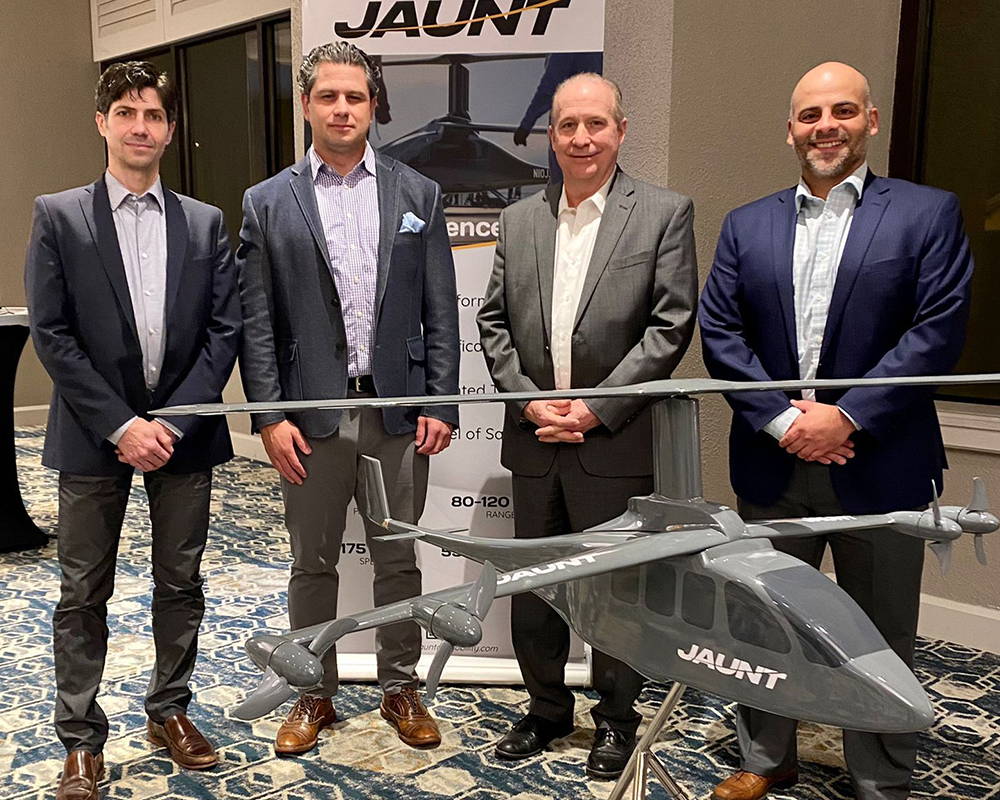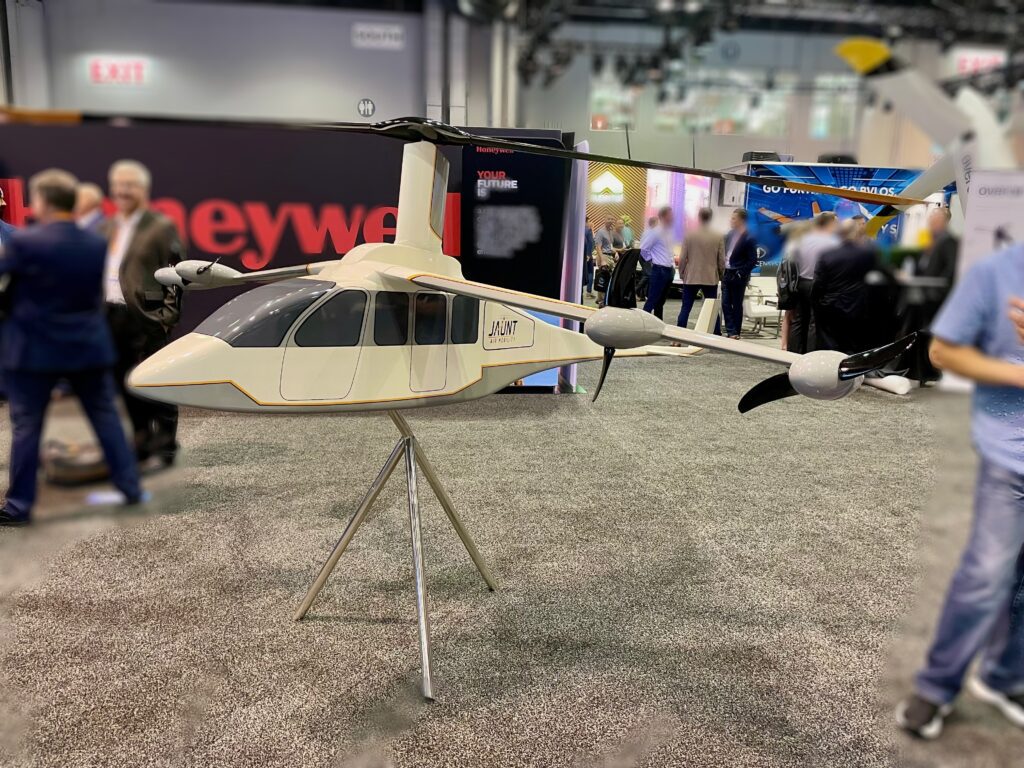Chief Commercial Officer at Jaunt Talks eVTOL Development


A sub-scale model of Jaunt’s eVTOL was on display at the 2022 NBAA-BACE. (Photo: Jessica Reed)
ORLANDO, Fla. — Jaunt Air Mobility, headquartered in Dallas, Texas, is building an electric vertical take-off and landing (eVTOL) aircraft as well as a hybrid-electric VTOL model. Jaunt has been a wholly owned subsidiary of The AIRO Group since March 2022. Jaunt’s focus is on electrifying advanced air mobility (AAM) operations to transport both people and cargo. The company’s design and manufacturing is located in Montreal, Canada.
Jaunt recently announced the formation of a new strategic partnership with South Korean startup MintAir. The partnership involves developing an AAM service in Korea, and MintAir signed a letter of intent to purchase as many as 40 eVTOL aircraft from its new partner.
The eVTOL developer started the Access Skyways alliance a couple of years ago to engage with experts in urban air mobility (UAM) infrastructure and to address future challenges in UAM. In February, the company Avports joined the Access Skyways alliance and signed a Memorandum of Understanding to collaborate with Jaunt in the integration of eVTOL vehicles into the existing ecosystem.
During last week’s NBAA Business Aviation Convention & Exhibition (NBAA-BACE), Simon Briceno, Chief Commercial Officer (CCO) at Jaunt Air Mobility shared his thoughts with Avionics International on the company’s progress in developing their eVTOL, partnerships and collaborations, and insights into the AAM industry. Briceno is also SVP of Strategy & Business Development for AIRO. Check out our question-and-answer session with Jaunt’s CCO below.

Pictured above on the right is Simon Briceno, Jaunt’s Chief Commercial Officer. (Photo: Jaunt)
Avionics International: Can you share some of the latest updates from Jaunt?
Briceno: We merged with five other companies as part of The AIRO Group, our parent company, earlier this year. We merged with the intent to go public through an IPO, and we announced in August that we filed our S1 registration statement with the SEC here in the U.S. to list publicly at some point in the future. We’re going through that process to raise the capital that we need.
We’ve also had an Air Force contract that ended in June with a focus on developing a high-speed VTOL aircraft that can fulfill high-speed missions with particular vertical take-off and landing and hovering requirements and certain payload requirements. We just finished Phase I. Phase II will be starting any time now [for the companies that are selected]. That’s important for us in terms of our relationship with the Air Force and AFWERX program. We’re working on the hybrid concept with the military in addition to our primary commercial program which is the all-electric aircraft.
Avionics International: In addition to the letter of intent from MintAir, what other LOIs has Jaunt signed?
Briceno: We’ve made progress in terms of securing some key customers throughout the year. We signed letters of intent for our aircraft, the Jaunt Journey, with a company in Brazil called Flapper Tecnologia that does on-demand operations using helicopters and business jets. They’ve been in operation in Brazil for many years.
We signed another LOI with Vertiko Mobility, an operator in Montreal, specifically targeting the advanced air mobility space and setting up operations in and around Quebec. We’re working on a few others that we can’t share just yet.
Avionics International: What progress has Jaunt made towards certification?
Briceno: We have been working closely with the Canadian government for support. There have been discussions for at least a year and a half now. We are meeting all of the requirements for applying, and engaging with them in the various funds and programs that they have—both at the provincial and federal level—to get support for the program. A lot of that is contingent, of course, on raising the capital on our end. They kind of go hand in hand. All of that, hopefully, will converge here soon, and our program timeline is still the same.
We intend to certify in 2027 and are working with Transport Canada for certification over the next several years. We’ll be starting our demonstrator aircraft development next year. Our target is 2024 for flight testing and demonstration with our pre-production full-scale piloted model.

The Jaunt Journey is designed to carry four passengers and is expected to have a top speed of 175 mph. (Photo: Jessica Reed)
Avionics International: What avionics systems will be onboard Jaunt’s eVTOL, and what will the pilot experience be like?
Briceno: We announced last year that we’re working with CAE for the development of several things—the main thing is our Systems Integration Lab. They have a ton of experience in developing engineering simulators and systems integration, and they’re going to be leading that program for Jaunt.
In parallel, they’ve been able to develop technologies for pilot training; they’ve been doing a lot of VR work, and they’re progressing nicely in that area. They’re working with some other companies in the AAM space to develop the capabilities and technologies that will be needed to train pilots. They will ensure not only that we have the number of pilots that we’ll need to operate, but also that it is cost-effective for them to get training. Developing ground-based simulation and training devices really helps to get costs down.
These aircraft are not your traditional aviation aircraft. They’re new technologies that have to be developed to replicate the behavior and the flight characteristics. All that work is ongoing with CAE, and we’re really happy with the progress they’re making. It will certainly ramp up once we get our demonstrator program up and running next year—they will be involved in a lot of that.
Avionics International: What do you see as the biggest challenges for eVTOL and other advanced air mobility aircraft?
Briceno: The challenges have remained relatively the same; they’ve only intensified, which is good, I think. If you look at it holistically, from an ecosystem standpoint, you have your aircraft challenges—technology development, new materials, new systems, fly-by-wire systems integration, pilot cabin, battery technology, and the ability to contain any failures with batteries. Additionally, certification is going to be extremely important for many of these aircraft. We’re fortunate to be able to have a certification basis that follows existing rotorcraft rules. We don’t see ourselves as having as many challenges in that area as some of the other players. The pilot shortage is another key challenge.
Once you start getting outside the aircraft—fortunately that’s something within the aircraft bubble that we can control with our suppliers and our experience certifying aircraft. One thing we have less control over, and have to devote more time and energy to, is informing the public about the value that this new transportation system and option will bring to them. There’s a perception from the public as to how noisy and disruptive helicopters are. There’s a lot of work to be done there.
The other challenge or hurdle that we’ll need to address over time is infrastructure charging—being able to operate these aircraft at the tempo and utilization that they’re going to be operated at with all the right infrastructure technology in place. Those are our areas that we’re looking at today that need to be addressed immediately, and over the next few years, to be confident that we can operate.
The post Chief Commercial Officer at Jaunt Talks eVTOL Development appeared first on Avionics International.
—————
Boost Internet Speed–
Free Business Hosting–
Free Email Account–
Dropcatch–
Free Secure Email–
Secure Email–
Cheap VOIP Calls–
Free Hosting–
Boost Inflight Wifi–
Premium Domains–
Free Domains





